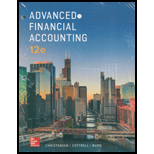
ADVANCED FINANCIAL ACCT.(LL) >CUSTOM<
12th Edition
ISBN: 9781260824292
Author: Christensen
Publisher: MCGRAW-HILL HIGHER EDUCATION
expand_more
expand_more
format_list_bulleted
Concept explainers
Question
Chapter 19, Problem 19.11Q
To determine
Introduction : Voluntary health and welfare organizations (VHWOs) provide a variety of social services. These organizations withdrawn funds from the community in large amount and typically provide services with a nominal amount to those with the ability to pay or free of cost to those who cannot pay. The federal government generally provides tax exempted status to these organizations.
The assets on which VHWO record fixed assets and if it records
Expert Solution & Answer
Want to see the full answer?
Check out a sample textbook solution
Students have asked these similar questions
Please fill the empty cell in this problem. It is the only thing I need.
Please explain the solution to this financial accounting problem with accurate principles.
What exactly are intangible assets and how are they defined? How are intangible assets different from plant assets?
Chapter 19 Solutions
ADVANCED FINANCIAL ACCT.(LL) >CUSTOM<
Ch. 19 - Prob. 19.1QCh. 19 - Prob. 19.2QCh. 19 - Prob. 19.3QCh. 19 - Prob. 19.4QCh. 19 - Prob. 19.5QCh. 19 - Prob. 19.6QCh. 19 - Prob. 19.7QCh. 19 - Prob. 19.8QCh. 19 - Prob. 19.9QCh. 19 - Prob. 19.10Q
Ch. 19 - Prob. 19.11QCh. 19 - Prob. 19.12QCh. 19 - Prob. 19.13QCh. 19 - Prob. 19.14QCh. 19 - Prob. 19.15QCh. 19 - Prob. 19.16QCh. 19 - Prob. 19.17QCh. 19 - Prob. 19.18QCh. 19 - Should a rotary club, an ONPO, report depreciation...Ch. 19 - Prob. 19.20QCh. 19 - Prob. 19.1CCh. 19 - Prob. 19.2CCh. 19 - Prob. 19.3CCh. 19 - Prob. 19.4CCh. 19 - Prob. 19.5CCh. 19 - Prob. 19.7CCh. 19 - Prob. 19.1.1ECh. 19 - Prob. 19.1.2ECh. 19 - Prob. 19.1.3ECh. 19 - Prob. 19.1.4ECh. 19 - Prob. 19.1.5ECh. 19 - Prob. 19.1.6ECh. 19 - Prob. 19.2.1ECh. 19 - Prob. 19.2.2ECh. 19 - Prob. 19.2.3ECh. 19 - Prob. 19.2.4ECh. 19 - Prob. 19.2.5ECh. 19 - Prob. 19.2.6ECh. 19 - Prob. 19.2.7ECh. 19 - Prob. 19.2.8ECh. 19 - Prob. 19.2.9ECh. 19 - Prob. 19.2.10ECh. 19 - Prob. 19.2.11ECh. 19 - Prob. 19.2.12ECh. 19 - Prob. 19.3ECh. 19 - Prob. 19.4ECh. 19 - Prob. 19.5.1ECh. 19 - Prob. 19.5.2ECh. 19 - Prob. 19.5.3ECh. 19 - Prob. 19.5.4ECh. 19 - Prob. 19.5.5ECh. 19 - Prob. 19.5.6ECh. 19 - Prob. 19.5.7ECh. 19 - Prob. 19.5.8ECh. 19 - Prob. 19.5.9ECh. 19 - Prob. 19.6ECh. 19 - Prob. 19.7ECh. 19 - Prob. 19.8.1ECh. 19 - Prob. 19.8.2ECh. 19 - Prob. 19.8.3ECh. 19 - Prob. 19.8.4ECh. 19 - Prob. 19.8.5ECh. 19 - Prob. 19.8.6ECh. 19 - Prob. 19.8.7ECh. 19 - Prob. 19.8.8ECh. 19 - Prob. 19.8.9ECh. 19 - Prob. 19.8.10ECh. 19 - Prob. 19.9ECh. 19 - Prob. 19.10PCh. 19 - Prob. 19.11PCh. 19 - Prob. 19.12PCh. 19 - Prob. 19.13PCh. 19 - Prob. 19.14PCh. 19 - Prob. 19.15PCh. 19 - Prob. 19.16PCh. 19 - Prob. 19.17PCh. 19 - Prob. 19.18PCh. 19 - Prob. 19.19PCh. 19 - Prob. 19.20PCh. 19 - Prob. 19.21PCh. 19 - Prob. 19.22PCh. 19 - Prob. 19.23PCh. 19 - Prob. 19.24.1PCh. 19 - Prob. 19.24.2PCh. 19 - Prob. 19.24.3PCh. 19 - Prob. 19.24.4PCh. 19 - Prob. 19.24.5PCh. 19 - Prob. 19.24.6PCh. 19 - Prob. 19.24.7PCh. 19 - Prob. 19.24.8PCh. 19 - Prob. 19.24.9PCh. 19 - Prob. 19.24.10PCh. 19 - Prob. 19.24.11PCh. 19 - Prob. 19.24.12PCh. 19 - Prob. 19.24.13PCh. 19 - Prob. 19.24.14PCh. 19 - Prob. 19.24.15PCh. 19 - Prob. 19.24.16PCh. 19 - Prob. 19.24.17PCh. 19 - Prob. 19.24.18PCh. 19 - Prob. 19.24.19PCh. 19 - Prob. 19.24.20PCh. 19 - Prob. 19.25PCh. 19 - Prob. 19.26P
Knowledge Booster
Learn more about
Need a deep-dive on the concept behind this application? Look no further. Learn more about this topic, accounting and related others by exploring similar questions and additional content below.Similar questions
- Answer this without using chatgtp or AIarrow_forwardNicole is a calendar-year taxpayer who accounts for her business using the cash method. On average, Nicole sends out bills for about $12,000 of her services on the first of each month. The bills are due by the end of the month, and typically 70 percent of the bills are paid on time and 98 percent are paid within 60 days. a. Suppose that Nicole is expecting a 2 percent reduction in her marginal tax rate next year. Ignoring the time value of money, estimate the tax savings for Nicole if she postpones mailing the December bills until January 1 of next year.arrow_forwardGeneral accountingarrow_forward
arrow_back_ios
SEE MORE QUESTIONS
arrow_forward_ios
Recommended textbooks for you
 Intermediate Accounting: Reporting And AnalysisAccountingISBN:9781337788281Author:James M. Wahlen, Jefferson P. Jones, Donald PagachPublisher:Cengage LearningPrinciples of Accounting Volume 1AccountingISBN:9781947172685Author:OpenStaxPublisher:OpenStax College
Intermediate Accounting: Reporting And AnalysisAccountingISBN:9781337788281Author:James M. Wahlen, Jefferson P. Jones, Donald PagachPublisher:Cengage LearningPrinciples of Accounting Volume 1AccountingISBN:9781947172685Author:OpenStaxPublisher:OpenStax College Cornerstones of Financial AccountingAccountingISBN:9781337690881Author:Jay Rich, Jeff JonesPublisher:Cengage Learning
Cornerstones of Financial AccountingAccountingISBN:9781337690881Author:Jay Rich, Jeff JonesPublisher:Cengage Learning

Intermediate Accounting: Reporting And Analysis
Accounting
ISBN:9781337788281
Author:James M. Wahlen, Jefferson P. Jones, Donald Pagach
Publisher:Cengage Learning

Principles of Accounting Volume 1
Accounting
ISBN:9781947172685
Author:OpenStax
Publisher:OpenStax College


Cornerstones of Financial Accounting
Accounting
ISBN:9781337690881
Author:Jay Rich, Jeff Jones
Publisher:Cengage Learning

ACCOUNTING BASICS: Debits and Credits Explained; Author: Accounting Stuff;https://www.youtube.com/watch?v=VhwZ9t2b3Zk;License: Standard Youtube License